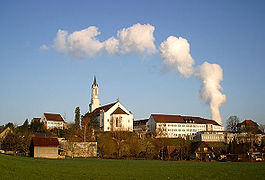Leuggern
| Leuggern | ||
|---|---|---|

Leuggern village
|
||
|
||
| Coordinates: 47°35′N 8°13′E / 47.583°N 8.217°ECoordinates: 47°35′N 8°13′E / 47.583°N 8.217°E | ||
| Country | Switzerland | |
| Canton | Aargau | |
| District | Zurzach | |
| Area | ||
| • Total | 13.76 km2 (5.31 sq mi) | |
| Elevation | 332 m (1,089 ft) | |
| Population (Dec 2015) | ||
| • Total | 2,130 | |
| • Density | 150/km2 (400/sq mi) | |
| Postal code | 5316 | |
| SFOS number | 4313 | |
| Surrounded by | Böttstein, Full-Reuenthal, Klingnau, Koblenz, Leibstadt, Mandach, Waldshut-Tiengen (DE-BW), Wil | |
| Website |
www SFSO statistics |
|
Leuggern is a municipality in the district of Zurzach in the canton of Aargau in Switzerland.
The remains of a Roman era Rhine fortifications watchtower have been discovered in Felsenau. The modern municipality of Leuggern is first mentioned in 1231 as Lutgern. In the 13th Century it was part of the Habsburgs Waldshut district. Starting in the 14th Century, it was a district under the Habsburg Vogt of Baden. After the conquest of Aargau in 1415 it was part of the Swiss Confederation controlled County of Baden. The major landholders were the Freiherr of Böttstein and the Freiherr of Bernau. The Freiherr of Bernau granted the Knights Hospitaller extensive property, which became the Commandry of Leuggern in 1248.
The village church is first mentioned in 1231 when it was in the possession of the knights. They also possessed other properties that they, Count Rudolf von Habsburg and, after 1239, Ulrich of Klingen were unsuccessfully fighting over. Initially their Commandry was based on Bubikon but began moving to Leuggern in 1248. By 1251, a monastery had been built. In 1257 seven monks are mentioned as living there. In 1268 the Commander moved his seat from Klingnau and managed both Commandry together until 1415 from there. It had extensive landholdings and was one of the best endowed Commandry in Upper Germany. The Grand Master merged the two Commandry together into a single unit, though each house had its own prior. The house at Leuggern was located in the diocese of Basel, while Klingnau was in the diocese of Constance.
...
Wikipedia




